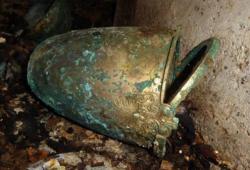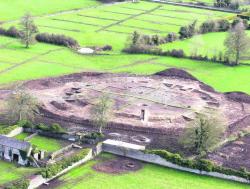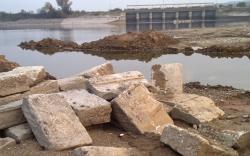INSTITUT SUPERIEUR D'ANTHROPOLOGIE
INSTITUTE OF ANTHROPOLOGY
ONLINE COURSES / COURS A DISTANCE
WINTER TERM : JANUARY 2015
REGISTER NOW
GRECE –  Aigai - Another tomb was unearthed this week in the cemetery of the tumuli at Aigai, northern Greece. According to head of the excavations, Angeliki Kottaridi, the tomb is unlooted. The announcement of the find was made by the excavator herself, in a Facebook post. The photos posted were of a metal strainer vase (a symposium vessel, in which wine was mixed with water) in situ, thus on the tomb’s floor. The bronze vessel’s decoration shows “the exceptional level of Macedonian metallurgy”, as Mrs. Kottaridi stresses in her post. The announcement text reads: “In the cemetery of the tumuli at Aigai a built (cist and not naos-shaped, which means Macedonian) grave of considerable dimensions was found, unlooted, a pleasant exception, since the Aigai necropolis had been brutally plundered by Gallic mercenaries of Pyrros in 276 BC and we rarely get the chance to find undisturbed burials. The deceased is a man who died during the time of Alexander the Great (336-323 BC). There is an interesting group of grave goods which -hopefully- will be exhibited in the first big exhibition for the inauguration of the new Aigai Museum. In order that you get an idea of what we saw today, here’s a photograph with the strainer vase (a symposium vessel in which they used to mix wine with water) where it was found, laying on the tomb’s floor… The scattered ”garbage” around it are remains of organic materials connected to the couch of the deceased… And a detail of the vessel’s decoration, so you can marvel the exceptional level of Macedonian metallurgy”.
Aigai - Another tomb was unearthed this week in the cemetery of the tumuli at Aigai, northern Greece. According to head of the excavations, Angeliki Kottaridi, the tomb is unlooted. The announcement of the find was made by the excavator herself, in a Facebook post. The photos posted were of a metal strainer vase (a symposium vessel, in which wine was mixed with water) in situ, thus on the tomb’s floor. The bronze vessel’s decoration shows “the exceptional level of Macedonian metallurgy”, as Mrs. Kottaridi stresses in her post. The announcement text reads: “In the cemetery of the tumuli at Aigai a built (cist and not naos-shaped, which means Macedonian) grave of considerable dimensions was found, unlooted, a pleasant exception, since the Aigai necropolis had been brutally plundered by Gallic mercenaries of Pyrros in 276 BC and we rarely get the chance to find undisturbed burials. The deceased is a man who died during the time of Alexander the Great (336-323 BC). There is an interesting group of grave goods which -hopefully- will be exhibited in the first big exhibition for the inauguration of the new Aigai Museum. In order that you get an idea of what we saw today, here’s a photograph with the strainer vase (a symposium vessel in which they used to mix wine with water) where it was found, laying on the tomb’s floor… The scattered ”garbage” around it are remains of organic materials connected to the couch of the deceased… And a detail of the vessel’s decoration, so you can marvel the exceptional level of Macedonian metallurgy”.
http://www.archaeology.wiki/blog/2014/11/13/another-macedonian-tomb-located-aigai/
USA –  Warsaw - Likely a regimental button with a detailed maker's mark on the underside, it's another sign of the past life of the Warsaw site that was home to Fort Johnson and Cantonment Davis.The sense of history infuses the site where earlier digs discovered the long-lost fort dating to the War of 1812 era. Work on the fort began about Sept. 7, 1814. It was burned to the ground just weeks later before U.S. troops, under the command of Zachary Taylor, a brevet major and later president of the United States, left for the safety of St. Louis after provisions ran short and ongoing harassment by the British and Sauk Indians. About 1,500 troops returned to the site in 1815 for Cantonment Davis, which housed soldiers who built a series of military trading posts, including Fort Edwards in Warsaw. "We're up here to commemorate the bicentennial of the founding and destruction of the fort. We're here essentially to walk in their footsteps at the same time they were here, trying to re-create some of the things they built," said Dave Nolan, Western Illinois Field Station Coordinator for the Illinois State Archaeological Survey Prairie Research Institute. A key feature of the site, a stone fireplace footing, likely was part of the fort, Nolan said, because cantonments typically were organized tent cities with no permanent installations. Another find, two British military buttons, "was the first kind of oddball thing we found that didn't really fit our expectations," Branstner said. The buttons came from the New Brunswick Regiment in northeastern Canada, which also served in the Lake Erie area during the War of 1182. The fort itself was small -- historians believe it was 100 feet by 100 feet -- with small buildings and "pretty tight quarters" for the 100 men behind its walls, said Rob Hickson with the State Archaeological Survey . "So little is known about the War of 1812 in Illinois on the western frontier," Hickson said. "This contributes to the understanding of what was going on in the pioneer days of Illinois. Our work here is contributing to the history of Illinois in a great way." The fort itself had cabins, a commissary where the soldiers ate, sleeping quarters, and a storage site for ammunition.
Warsaw - Likely a regimental button with a detailed maker's mark on the underside, it's another sign of the past life of the Warsaw site that was home to Fort Johnson and Cantonment Davis.The sense of history infuses the site where earlier digs discovered the long-lost fort dating to the War of 1812 era. Work on the fort began about Sept. 7, 1814. It was burned to the ground just weeks later before U.S. troops, under the command of Zachary Taylor, a brevet major and later president of the United States, left for the safety of St. Louis after provisions ran short and ongoing harassment by the British and Sauk Indians. About 1,500 troops returned to the site in 1815 for Cantonment Davis, which housed soldiers who built a series of military trading posts, including Fort Edwards in Warsaw. "We're up here to commemorate the bicentennial of the founding and destruction of the fort. We're here essentially to walk in their footsteps at the same time they were here, trying to re-create some of the things they built," said Dave Nolan, Western Illinois Field Station Coordinator for the Illinois State Archaeological Survey Prairie Research Institute. A key feature of the site, a stone fireplace footing, likely was part of the fort, Nolan said, because cantonments typically were organized tent cities with no permanent installations. Another find, two British military buttons, "was the first kind of oddball thing we found that didn't really fit our expectations," Branstner said. The buttons came from the New Brunswick Regiment in northeastern Canada, which also served in the Lake Erie area during the War of 1182. The fort itself was small -- historians believe it was 100 feet by 100 feet -- with small buildings and "pretty tight quarters" for the 100 men behind its walls, said Rob Hickson with the State Archaeological Survey . "So little is known about the War of 1812 in Illinois on the western frontier," Hickson said. "This contributes to the understanding of what was going on in the pioneer days of Illinois. Our work here is contributing to the history of Illinois in a great way." The fort itself had cabins, a commissary where the soldiers ate, sleeping quarters, and a storage site for ammunition.
http://www.therepublic.com/view/story/65ad6e66c45c494f956ee8b720a3e4c3/IL--Fort-Johnson
IRLANDE –  Galway - A hunter’s campsite, a Bronze Age lead mine, a prehistoric hill fort and early medieval farmsteads are among the litany of ancient finds along the Galway to Ballinasloe motorway route which have been compiled in a book to be launched next week.“The Quiet Landscape describes a hunter-gatherer camp site at Ballynaclogh; a Bronze Age lead mine at Treanbaun; a great prehistoric hill fort at Rahally; prehistoric cremation burials at Newford, Deerpark and Rathglass,” said Mr O’Sullivan, who is the National Roads Authority Archaeologist in Galway.
Galway - A hunter’s campsite, a Bronze Age lead mine, a prehistoric hill fort and early medieval farmsteads are among the litany of ancient finds along the Galway to Ballinasloe motorway route which have been compiled in a book to be launched next week.“The Quiet Landscape describes a hunter-gatherer camp site at Ballynaclogh; a Bronze Age lead mine at Treanbaun; a great prehistoric hill fort at Rahally; prehistoric cremation burials at Newford, Deerpark and Rathglass,” said Mr O’Sullivan, who is the National Roads Authority Archaeologist in Galway.
http://connachttribune.ie/galway-motorway-excavation-sees-soil-throw-ancient-secrets-846/
GRECE –  Amphipolis - To launch the work of the reconstruction of the Kasta mound, the scattered architectural members identified and assigned to the precinct are being studied systematically. About 500 marble elements have been located in the surrounding area where the Lion of Amphipolis today stands. The receding waters of the nearby lake Kerkinis have also revealed more than a hundred members of the precinct, including cornices, pillars and crowns, used in the construction of the Kerkinis dam in 1936.
Amphipolis - To launch the work of the reconstruction of the Kasta mound, the scattered architectural members identified and assigned to the precinct are being studied systematically. About 500 marble elements have been located in the surrounding area where the Lion of Amphipolis today stands. The receding waters of the nearby lake Kerkinis have also revealed more than a hundred members of the precinct, including cornices, pillars and crowns, used in the construction of the Kerkinis dam in 1936.
http://www.yppo.gr/3/e30.jsp
BOLIVIE –  Mairana - A circular pyramid of more than 2,000 years old was discovered in the municipality of Mairana, in the eastern Bolivian department of Santa Cruz, archaeologist Danilo Drakit stated today. The also coordinator of the Archaeology Project in the government of Santa Cruz stressed that the pyramid is located near Fuerte de Samaipata, declared World Heritage Site by UNESCO. "The pyramid is composed by three circular bodies, has five entrances, the main one is looking south and includes two hectares of floor space," he stressed. He also said that its construction could be linked to Fuerte de Samaipata and other archaeological sites in Santa Cruz valleys, even to others located in the Bolivian Chaco region. The pyramid will be totally visible for late 2015, according to the archaeologist, who said the arrival of the rainy season in the region will force them to stop excavations.
Mairana - A circular pyramid of more than 2,000 years old was discovered in the municipality of Mairana, in the eastern Bolivian department of Santa Cruz, archaeologist Danilo Drakit stated today. The also coordinator of the Archaeology Project in the government of Santa Cruz stressed that the pyramid is located near Fuerte de Samaipata, declared World Heritage Site by UNESCO. "The pyramid is composed by three circular bodies, has five entrances, the main one is looking south and includes two hectares of floor space," he stressed. He also said that its construction could be linked to Fuerte de Samaipata and other archaeological sites in Santa Cruz valleys, even to others located in the Bolivian Chaco region. The pyramid will be totally visible for late 2015, according to the archaeologist, who said the arrival of the rainy season in the region will force them to stop excavations.
http://www.plenglish.com/index.php?option=com_content&task=view&id=3262751&Itemid=1
LIBAN – 
 Kawkaba - An archeological site dating back to the Phoenician era was discovered in a south Lebanon village Tuesday, as bulldozers working on a road uncovered a cave containing antique stoneware, lanterns and human bones. The National News Agency said the archeological treasure was found in a grotto in the village of Kawkaba, including pottery jars of different sizes and 50 lanterns of various shapes, in addition to remains of human skeletons. The cave, dug inside a lime rock, consisted of three separate chambers, with each containing a tomb 180 centimeters wide and 75 centimeters deep, the NNA said.
Kawkaba - An archeological site dating back to the Phoenician era was discovered in a south Lebanon village Tuesday, as bulldozers working on a road uncovered a cave containing antique stoneware, lanterns and human bones. The National News Agency said the archeological treasure was found in a grotto in the village of Kawkaba, including pottery jars of different sizes and 50 lanterns of various shapes, in addition to remains of human skeletons. The cave, dug inside a lime rock, consisted of three separate chambers, with each containing a tomb 180 centimeters wide and 75 centimeters deep, the NNA said.
http://www.dailystar.com.lb/News/Lebanon-News/2014/Nov-11/277232-road-work-unearths-phoenician-grotto-in-south-lebanon.ashx#axzz3Iw0Sn0jX